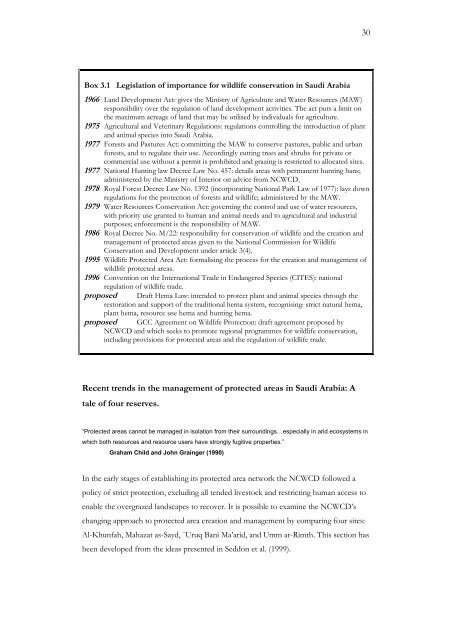The Unfenced Desert Towards a strategy for eco ... - Nwrc.gov.sa
The Unfenced Desert Towards a strategy for eco ... - Nwrc.gov.sa
The Unfenced Desert Towards a strategy for eco ... - Nwrc.gov.sa
You also want an ePaper? Increase the reach of your titles
YUMPU automatically turns print PDFs into web optimized ePapers that Google loves.
Box 3.1 Legislation of importance <strong>for</strong> wildlife conservation in Saudi Arabia<br />
1966 Land Development Act: gives the Ministry of Agriculture and Water Resources (MAW)<br />
responsibility over the regulation of land development activities. <strong>The</strong> act puts a limit on<br />
the maximum acreage of land that may be utilised by individuals <strong>for</strong> agriculture.<br />
1975 Agricultural and Veterinary Regulations: regulations controlling the introduction of plant<br />
and animal species into Saudi Arabia.<br />
1977 Forests and Pastures Act: committing the MAW to conserve pastures, public and urban<br />
<strong>for</strong>ests, and to regulate their use. Accordingly cutting trees and shrubs <strong>for</strong> private or<br />
commercial use without a permit is prohibited and grazing is restricted to allocated sites.<br />
1977 National Hunting law Decree Law No. 457: details areas with permanent hunting bans;<br />
administered by the Ministry of Interior on advice from NCWCD.<br />
1978 Royal Forest Decree Law No. 1392 (incorporating National Park Law of 1977): lays down<br />
regulations <strong>for</strong> the protection of <strong>for</strong>ests and wildlife; administered by the MAW.<br />
1979 Water Resources Conservation Act: <strong>gov</strong>erning the control and use of water resources,<br />
with priority use granted to human and animal needs and to agricultural and industrial<br />
purposes; en<strong>for</strong>cement is the responsibility of MAW.<br />
1986 Royal Decree No. M/22: responsibility <strong>for</strong> conservation of wildlife and the creation and<br />
management of protected areas given to the National Commission <strong>for</strong> Wildlife<br />
Conservation and Development under article 3(4).<br />
1995 Wildlife Protected Area Act: <strong>for</strong>malising the process <strong>for</strong> the creation and management of<br />
wildlife protected areas.<br />
1996 Convention on the International Trade in Endangered Species (CITES): national<br />
regulation of wildlife trade.<br />
proposed Draft Hema Law: intended to protect plant and animal species through the<br />
restoration and support of the traditional hema system, r<strong>eco</strong>gnising: strict natural hema,<br />
plant hema, resource use hema and hunting hema.<br />
proposed GCC Agreement on Wildlife Protection: draft agreement proposed by<br />
NCWCD and which seeks to promote regional programmes <strong>for</strong> wildlife conservation,<br />
including provisions <strong>for</strong> protected areas and the regulation of wildlife trade.<br />
Recent trends in the management of protected areas in Saudi Arabia: A<br />
tale of four reserves.<br />
“Protected areas cannot be managed in isolation from their surroundings…especially in arid <strong>eco</strong>systems in<br />
which both resources and resource users have strongly fugitive properties.”<br />
Graham Child and John Grainger (1990)<br />
In the early stages of establishing its protected area network the NCWCD followed a<br />
policy of strict protection, excluding all tended livestock and restricting human access to<br />
enable the overgrazed landscapes to r<strong>eco</strong>ver. It is possible to examine the NCWCD’s<br />
changing approach to protected area creation and management by comparing four sites:<br />
Al-Khunfah, Mahazat as-Sayd, `Uruq Bani Ma’arid, and Umm ar-Rimth. This section has<br />
been developed from the ideas presented in Seddon et al. (1999).<br />
30

















